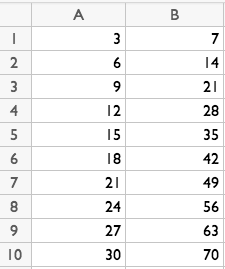Lesson 8
Spreadsheet Shortcuts
Problem 1
Technology required. Open a blank spreadsheet. Use "fill down" to recreate this table of equivalent ratios. You should not need to type anything in rows 3–10.

Solution
For access, consult one of our IM Certified Partners.
Problem 2
A list of numbers is made with the pattern: Start with 11, and subtract 4 to find the next number.
Here is the beginning of the list: 11, 7, 3, . . .
Explain how you could use "fill down" in a spreadsheet to find the tenth number in this list. (You do not need to actually find this number.)
Solution
For access, consult one of our IM Certified Partners.
Problem 3
Here is a spreadsheet showing the computations for a different version of the birthday trick:

Explain what formulas you would enter in cells B4 through B8 so that cell B8 shows a number representing the month and day. (In this example, cell B8 should show 704.) If you have access to a spreadsheet, try your formulas with a month and day to see whether it works.
Solution
For access, consult one of our IM Certified Partners.
Problem 4
Write a formula you could type into a spreadsheet to compute the value of each expression.
- \(\frac25\) of 35
- \(25 \div \frac53\)
- \(\left( \frac{1}{11} \right) ^ 4\)
- The average of 0, 3, and 17
Solution
For access, consult one of our IM Certified Partners.
(From Unit 1, Lesson 7.)Problem 5
The data set represents the number of cars in a town given a speeding ticket each day for 10 days.
- 2
- 4
- 5
- 5
- 7
- 7
- 8
- 8
- 8
- 12
- What is the median? Interpret this value in the situation.
- What is the IQR?
Solution
For access, consult one of our IM Certified Partners.
(From Unit 1, Lesson 5.)Problem 6
The data set represents the most recent sale price, in thousands of dollars, of ten homes on a street.
- 85
- 91
- 93
- 99
- 99
- 99
- 102
- 108
- 110
- 115
- What is the mean?
- What is the MAD?
Solution
For access, consult one of our IM Certified Partners.
(From Unit 1, Lesson 5.)